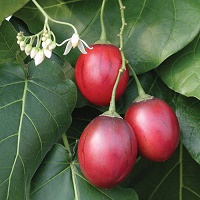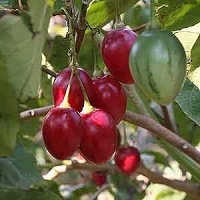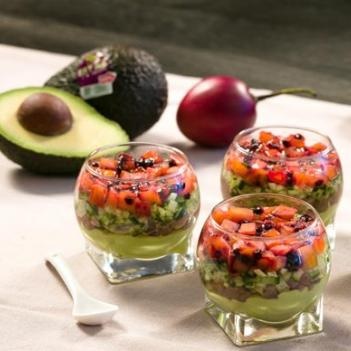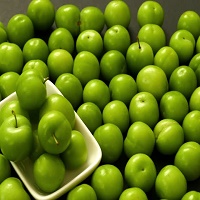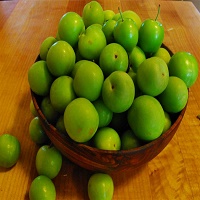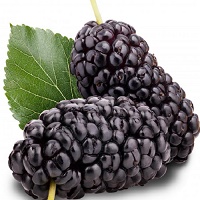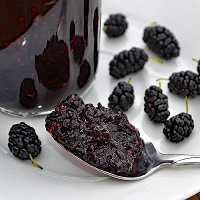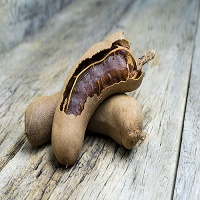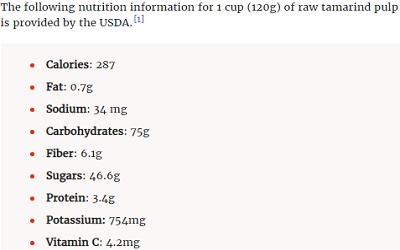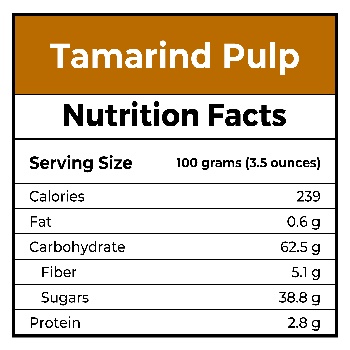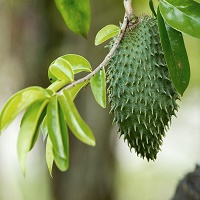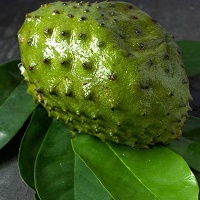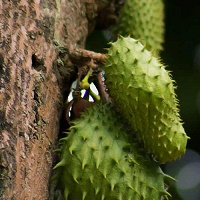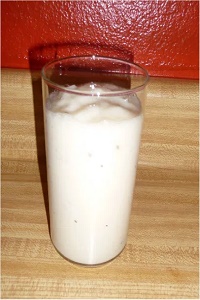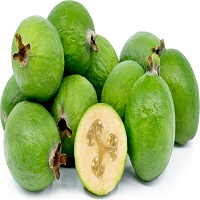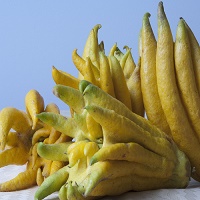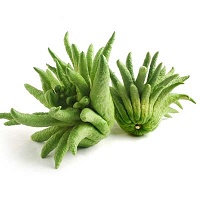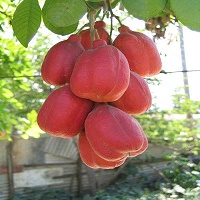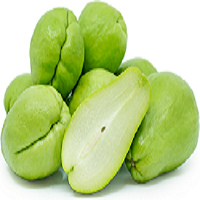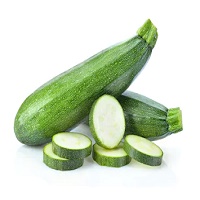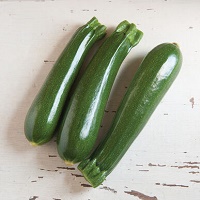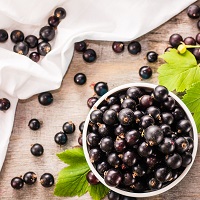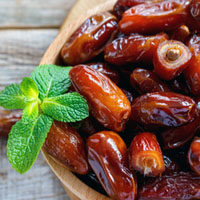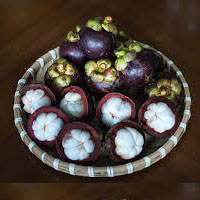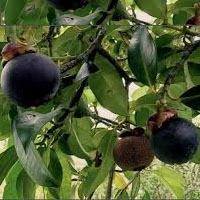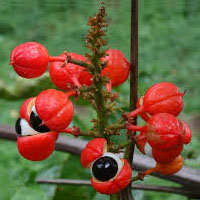Top Fruit Health Benefit 60-40
There are more than 2000 fruits, but each one has unique features and health benefits. Fruits are consumed by everyone on a daily basis. But how many of us know the health benefits of fruits? So this site provides you health benefits and characteristics of different fruits.
 Full List of Fruits
Full List of Fruits  Top Fruit Health Benefit 60-40
Top Fruit Health Benefit 60-40
60.Tamarillo
59.Sour Plum
58.Mulberries
57.Tamarind
56.Guanabana
55.Feijoa
54.Lucuma
53.Buddha's hand
52.Ackee
51. Monstera Deliciosa
50.Chayote
49.Zucchini
48.Muskmelon
47.Bilberry
46.Dragon fruit
45.Kiwano melon
44.Acai berry
43.Date plam
42.Mangosteen
41.Guarana
An egg-shaped fruit with a tart, astringent, and pulpy flesh that you can scoop out with a spoon. The tamarillo is native to South America. The fruits are egg-shaped and about 4-10 centimeters long. The fruits are very high in vitamins and iron and low in calories (only about 40 calories per fruit). Their color varies from yellow and orange to red and almost purple. Sometimes they have dark, longitudinal stripes. The tamarillo prefers subtropical climate, with rainfall between 600 and 4000 millimeters and annual temperatures between 15 and 20 °C. The fruits are high in pectin and therefore have good properties for preserves. However, they oxidize and lose color when not treated. Yellow fruit types are better suited to industrial use.
Description
The plant bears fruit of egg shaped which measures about 4 to 10 centimeters long. The color of the fruit differs from yellow and orange to red and purple. It may have dark and longitudinal stripes. Yellow or orange fruits are sweeter and red fruits are acetous. Flesh has firm texture and possesses larger seeds.
Nutritional Value
Tamarillo provides a great amount of dietary fiber, protein, minerals and vitamins. It has high content of carotenoid pigments such as ß-carotene, ?-carotene, ß-cryptoxanthin, zeaxanthin and lutein. Besides this, it also includes vitamins such as Vitamin B6, Vitamin C and Vitamin E. Vitamin A and Vitamin C content found in tamarillo makes a very good antioxidant. It also contains phytonutrient such as anthocyanin, phenolics, flavonoids and carotenoid.
Health Benefits
- Tamarillo has phytonutrients that offers antioxidant activity and lowers the chances of degenerative diseases such as cancer, cataracts, Parkinson's disease, heart disease, diabetes and Alzheimer's disease.
- Tomatoes are known for its benefit to improve vision and eye health. Tamarillo is also beneficial for maintaining eyesight.
- Potassium is found in ample amounts in tamarillo which assist in controlling heart rate as well as blood pressure. It balances harmful effects of sodium on heart.
- The presence of citric acid in Tamarillo causes acidic flavor. Add tamarillo to the diet to lower the chances of kidney stones.
- Tamarillo is rich in nutrients which lowers the chances of cancer with its antioxidant properties. Anthocyanins possess anti-cancer properties.
- Tamarillo offers Vitamin E, Vitamin C and Vitamin A which builds blocks of skin. The daily intake of tamarillo assures that the body is not deprived of nutrients and makes the skin healthy. It prevents aging of skin due to UV light and pollution.
- Scientific studies show that tamarillo is beneficial for diabetic people. Tamarillo has chlorogenic acid which helps to lower blood sugar in Type II diabetes.
- Tamarillos possess wide range of antimicrobial activity which was the result of protein that inhibits action of enzyme invertase.
- For sore throat, warm the leaves and wrap it around neck.
- Cook the pulp in embers and use it as a poultice for inflamed tonsils.
Recipe
Tuna tartare with avocado
Ingrediants
- 2 tamarillos
- 2 avocados
- 1 lime
- ½ cucumber
- 200 g fresh tuna
- 1 tbsp. olive oil
- salt & pepper
Method
- Cut the avocado all the way around, going as deep as the stone. Twist until you can pull the 2 halves apart. Remove the stone with a spoon. Peel the avocado or scoop the flesh out.
- Mash the avocado together with half the lime juice and season with salt and pepper.
- Cut the tuna into small cubes.
- Mix the tuna with the other half of the lime juice and salt and pepper.
- Cut the cucumber into very small cubes.
- Peel the tamarillo and cut into little cubes.
- Create layers in a small glass. Start with the avocado, then the tuna and then the cucumber and tamarillo.
How to consume
- Consume the fruit by scooping the fresh.
- Flesh could be lightly sugared and cooled which could be used for breakfast.
- It could be added to stews, chutneys, hollandaise and curries.
- Add it to dessert or combine it with apples.
- Tamarillo could be baked, grilled or boiled and serve it with fish, burger or steak.
Precautions
- Avoid by the people with known allergy.
- Use it in moderate amounts.
- People with health ailments should consult the doctor before use.
Tamarillo season begins in New Zealand from May until October. Choose well-developed, bright, uniform colored, ripe and ready to eat fruits. Tamarillos are available in several attractive colors of orange, golden yellow, deep red, maroon, etc. Look for the healthy stalk. Avoid small, shriveled, damaged and bruised fruits.
The Sour Plum also is known as a Cherry Plum is the main ingredient of a tangy Georgian sauce called Tkemali. Tkemali is the Georgian name for cherry plum, as well as sauce made of cherry plums. Tkemali is made from both red and green varieties. Sour plums are available in the spring. The Sour plum has incredibly high acidity levels, offering bright but lean flavors of rhubarb, lemon and tart green apple. The sweet-sour fruit is rich in vitamin C, K, copper, dietary fibre and potassium, while being quite low on calories, with 100 grams of plums containing 46 calories and absolutely no saturated fats.
Health Benefits

- Sour plum is rich in vitamin A which is an essential vitamin that helps us achieve a healthy vision.
- Blueberries are rich in antioxidants which helps in protecting our cell membranes from free radical damage.
- Sour plums are high in potassium, which is a mineral that is essential to ensure the proper functioning of the heart .Having a sufficient potassium intake every day can help lower blood pressure, which in turn can reduce the risk of having problems such as heart disease, heart attack, dizziness, and stroke.
- Sour plums and prunes help the body to digest food properly, have a regular bowel movement, and relieve constipation.
- According to research, prunes might be able to reverse osteoporosis, especially in postmenopausal women.
- Sour plums also contain anti-inflammatory properties, which is why it is highly recommended that people have arthritis.
- Being iron deficient can cause dryness and discoloration of hair as well as hair loss. Eating or consuming sour plum can be a great source of iron, which in term helps contribute to the overall health of your hair and give countless benefits to it.
- The vitamins and minerals that can be found in sour plums are helpful when it comes to maintaining healthy and clear skin.
- This fruit also helps to slow down the body's aging process, which in turn delays the development of wrinkles.
Recipe
Japanese Plum Rice
Ingredients:
- 2 1/2 Cups Rice
- 2 Large size Japanese Plum
- 3 Tbsp Dashi Soy
- Sesame Seeds by taste
Procedure
- Rinse the rice with water 30 minutes before cooking and leave in a strainer. Put the rice, Japanese plum and the Dashi Soy in the rice cooker.
- When the rice is done cooking, let it steam for 10 minutes, take the seed out of the Japanese plums and mix it all together.
- Put the rice in rice bowls and sprinkle sesame seeds on top.
Side effects of cherimoya fruit
- Hydrogen cyanide, toxin is found mainly in the leaves and seed and is readily detected by its bitter taste.
- In excess, however, it can cause respiratory failure and even death.
- It shouldn't be used by patients of bacillary dysentery and the initial stage of enteritis.
- It shouldn't be used by Women during normal menstrual period.
Green dye can be obtained from the leaves. Dark grey to green dye can be obtained from the fruit. Tree will begin fruiting in 3-5 growing seasons.
An elongated red berry that grows on a small bushy, tree. It's native to China and was historically grown as fruit for silkworm larvae. Mulberry (Morus) belongs to the Moraceae plant family and includes several species, such as the black mulberry (M. nigra), red mulberry (M. rubra), and white mulberry (M. alba). Mulberry trees produce flavorful berries that are enjoyed around the world and often deemed superfoods due to their concentration of vitamins, minerals, and powerful plant compounds. However, the fruit isn't the only part of the mulberry tree that may offer health benefits. For centuries, its leaves have been used in traditional medicine as a natural treatment for a variety of conditions. In fact, the leaves are highly nutritious. They're loaded with powerful plant compounds like polyphenol antioxidants, as well as vitamin C, zinc, calcium, iron, potassium, phosphorus, and magnesium.
Description
Fruit is oblong, short stalked measuring 2 to 3 centimeters long and dark purple to black in color which grows in a cluster of several small drupes. Mulberries have refreshing, saccharine, subacid taste with fine aroma.
Types
- Black Mulberry: The black mulberry is used to cure mouth diseases, epilepsy, insomnia, diabetes, urinary tract infections, throat, depression and dizziness. The diarrhea is cured by fresh immature mulberries and mature one is used for laxative. The black mulberry leaves are used for blood sugar control and it is used in tea to treat diabetes.
- White Mulberry: White mulberry serves the purposes such as stain removal, skin whitening and spot due to its presence of inhibitors which lessens the synthesis of melanin. It is used in the cosmetic products for cleansing and toning the face, anti-aging skin treatment. It aids in eye diseases, arthritis, weakness and ease nervous system. The author of the book "Plants against Cancer"; Jonathan Hartwell believes that the throat cancer can be cured with white mulberry juice.
Health Benefits
- Dietary fiber helps in improving your digestion by bulking up stool and speeding up the movement of food through the digestive tract. This reduces the occurrences of constipation, bloating, and cramping.
- Mulberry leaves can be used to treat extremely dry skin by infusing them in coconut or olive oil for a few days and thereafter applying the oil onto your skin.
- Mulberry is known to aid in the production of melanin in your hair. This allows you to retain your hair's natural colour. It is especially beneficial for people who suffer from premature greying of the hair.
- Mulberries, like all the other berries, are rich in anti-oxidants which are renowned as effective anti-aging agents and promote glowing, youthful skin.
- Eating mulberries is beneficial for your heart. It strengthens the nervous system and reduces bad cholesterol thus preventing the blockage in the flow of blood. So, it can reduce the risk of heart attacks and strokes.
- Drinking a glass of mulberry juice every day may help improve your vision. It has a high content of Vitamin A which is good for strengthening your eyesight and relieving eye strains.
- Vitamin C is a great weapon against any infection and foreign pathogens as it makes you stronger from within.
- The high iron content in mulberries can significantly boosts the production of red blood cells which helps the body to increase its distribution of oxygen to important tissues and organ systems
Traditional Uses
- Leaves are internally used for treating influenza, colds, nosebleeds and eye infections.
- The tincture made from bark is used to provide relief from toothache.
- Fruits are used for treating tinnitus, urinary incontinence, constipation and premature greying of hair.
- Use the root bark internally for treating coughs, asthma, oedema, bronchitis, diabetes and hypertension.
- Bark is used to eliminate tape worms.
- The plant extracts possess fungicidal and antibacterial activities.
- It is also used to treat diabetes.
- Use it as a gargle to provide relief from sore throat.
How to consume
- Due to its tart or sweet flavor, it is used for making jellies, jams, sherbets, pies, fruit tarts, teas, wines and cordials.
- Mulberries and its leaves are used for making teas and other beverages.
- It is also used as a filling for pies.
- Add it to desserts.
- Use it in smoothies, ice creams and yogurt.
Recipe
Mulberry Jam
Ingredients
- Mulberry berries 3.36 lbs. (1.5 kg)
- Cane sugar 10.5 oz. (300 grams)
- Pectin 1 bag
Method
- Clean and rinse the berries. Remove all the peduncles.
- Put in a large bowl and cover it with cane sugar and pectin.
- Over low heat, stir the mixture until the sugar melts.
- Prepare bottles to be used to store the jam, by sterilizing it in hot boiling water.
- The dried bottles are then placed in a large pot of water (that will be used as the boiling bath). Pour the jam into these bottles and boil it for 10 minutes.
- Then immediately cover the bottles, cool and refrigerate.
Precautions
- Mulberries could cause skin cancer.Arbutin is a hydroquinone which assists in prevention of melanin release by containing tyrosinase enzyme.
- Mulberries are packed with potassium which worsens the gall bladder pains or kidney disorders.
- Mulberries help to reduce blood sugar and could cause hypoglycemia. Hypoglycemia is a condition which results in hunger, headache, dizziness, blurred vision, confusion, excessive sweating and tremors. One should consume mulberries in moderate amounts with caution.
- Mulberries obstructs in absorption of carbohydrates. It could hamper carbohydrate and triacyglycerol absorption.
- The patients of liver problems if consumed mulberries causes load on liver and damages organ. So avoid by the people having liver problems.
- Some people experience side effects such as irritation, pain and cramps after consuming mulberries.
- It might cause harmful side effects in pregnant and breastfeeding women. So pregnant women should consult the doctor before consuming mulberries to remain on safe side.
The leaves of Mulberry grow in bunches which are known as drupes and are favorite of silkworms. After the 10 years of plantation only, the trees produce fruit. Mulberry essential oil are added to shampoos, lotions, candles and soaps.
The tamarind is a long-lived, medium-growth tree, which attains a maximum crown height of 12 to 18 metres (40 to 60 feet). Tamarind is a hardwood tree known scientifically as Tamarindus indica. It's native to Africa but also grows in India, Pakistan and many other tropical regions. The tree produces bean-like pods filled with seeds surrounded by a fibrous pulp. The pulp of the young fruit is green and sour. The pulp of the young fruit is green and sour. As it ripens, the juicy pulp becomes paste-like and more sweet-sour. Interestingly, tamarind is sometimes referred to as the "date of India."
Description
Tamarind is a tree. Its partially dried fruit is used to make medicine. People take tamarind for constipation, liver and gallbladder problems, and stomach disorders. It is also used to treat colds and fever. Women sometimes use tamarind to treat pregnancy-related nausea. It is given to children to treat intestinal worms. Sometimes a thick paste of tamarind seeds is used as a cast for broken bones. An extract of tamarind seeds is used in eye drops for dry eyes. In foods and beverages, tamarind is used as flavoring. It is also widely used in Asian cooking for chutneys and curries.
Variety
There are two major forms of tamarind. The most common form is the one that tastes sour. The other form is sweet tamarind that is usually grown in Thailand.
Health Benefits
- May Mitigate Liver Injury
- Can Help Exfoliate And Lighten Your Skin
- May Aid Weight Management
- May Relieve Stomach Ache And Constipation
- May Control Hypertension And Promote Heart Health
- May Help Manage Diabetes and Hyperglycemia
- Can Help Prevent Malaria And Microbial Diseases
Medicinal Uses
- Its pulp has been used in many traditional medicines as a laxative, digestive, and as a remedy for biliousness and bile disorders.
- This spice condiment is also used as an emulsifying agent in syrups, decoctions, etc., in different pharmaceutical products.
Tamarind is considered good for constipation due to its laxative property. It helps to boost immunity as it is rich in vitamin C and antioxidants, making it useful in managing common cold. Tamarind powder might also help to manage blood sugar as well as insulin levels and is thus considered good for diabetic patients. It might also be beneficial for people trying to manage weight as it helps decrease food cravings thereby preventing overeating.
Guanabana is the largest edible fruit in the family of custard apples. The fruits are in oval shape, dark green color with spiky crust which can grow up to 30 cm long. It has a heavenly taste with mixed flavor of strawberries and apple with creamy banana texture. Some claim that guanabana tastes like a combination of mango and pineapple. The fully ripped guanabanas are in yellowish green color with the aroma of pineapple. It can be eaten ripe, or used to make juices, smoothies and ice cream. Guanabana is a high water content fruit which contains a significant amount of Vitamin C and carbohydrates.
Health Benefits
- Soursop Fights Cancer
- Improves Eye Health
- Helps Fight Inflammation
- It Vitamin C in it which assist the body to cope with stress by lowering high stress levels, cortisol and hormones.
- Helps Treat Infections
- Soursop Aids Diabetes Treatment
- Boosts Kidney And Liver Health
- Improves Respiratory Health
- Helps Relieve Stress
- Enhances Gastrointestinal Health
- Boosts The Immune System
- Relieves Pain (Works As An Analgesic)
- Soursop Treats Fever
- Treats Diarrhea
- Aids In The Treatment Of Hypertension
- Helps Treat Rheumatism
- Improves Skin And Hair Healthave
Nutritional Value
Soursop contains abundant amounts of vitamin C and several B vitamins like thiamin, riboflavin, and niacin as well as minerals like calcium, phosphorus and a small amount of iron. The fruit comprises of 67.5% pulp, 20% fruit skin, 8.5% fruit seeds and 4% core pieces. Know about nutritional benefits of soursop fruit.
Side effects
- Eye Inflammation: The seeds and bark of the soursop tree are considered toxic. They contain potentially poisonous compounds like anonaine, hydrocyanic acid, and muricine. These can cause eye inflammation
- Issues With Pregnancy And Breastfeeding : This is because the high energy in the cells of the developing fetus can trigger the fruit's toxic activity – potentially harming the baby and the mother, with the baby at a greater risk.
- Consuming soursop had resulted in drastic weight loss in the mice
- Consuming soursop can result in the development of Parkinson's disease
Recipe
Guanabana Milkshake
Ingredients
- A cup of milk
- 1/2 cup of soursop pulp
- 7-8 ice cubes
- 1 1/2 teaspoons of sugar
- 1/2 teaspoon of pistachio, for garnish
Directions
- Cut the soursop fruit into half. Scoop the pulp out and remove the seeds.Add all the ingredients to a blender and make a smoothie.
- Pour the smoothie into a serving glass.
- Garnish with pistachios.
It resembles a custard apple and is dark green when raw. As it ripens, it becomes slightly soft and light green externally. Thus, this fruit is closely related to custard apple and cherimoyas in terms of appearance and flavor. Its white pulpy flesh contains small shiny black inedible seeds and has a sweet, acidic taste.
Feijoa is green, oval with the size of a chicken egg. It has a sweet flavor that reminds us of strawberry pineapple with a hint of mint. The fruit has a gelatinous pulp gritty texture like guava. Feijoa has a distinctive smell which is used in some natural cosmetic products and it acts as an exfoliant. It is sliced open and scooped out with a spoon like kiwi fruit. It is an abundant source of antioxidants, well known for their protective health benefits. Feijoa is used to reduce inflammation and blood clotting. It plays a vital role in regulating blood pressure.
Description
Fruit measuring 5 to 8 cm long by 3 to 6 cm diameter, is oblong to ovoid in shape having persistent calyx segments complied to apex. It has waxy skin in blue or grayish green or dull blue to green color. The texture of the skin varies from rough to smooth. The fruit possess long lasting perfume. Flesh of the fruit is white, thick, granular and translucent which is enclosed with seeds.
Health benefits
- Feijoa helps support the digestive system.
- Feijoa is less likely to spike your blood sugar levels.
- Feijoa can help you maintain a healthy blood pressure.
- It can health decrease the risk for heart disease.
- It can help you fight off infections.
- It can assist in antioxidant defense.
- Feijoa may improve focus, concentration, and memory.
Traditional Uses
- In native countries, Feijoa are used to treat thyroid gland diseases due to high content of iodine.
- The tea prepared from fruit and flowers is helpful for treating diarrhea and dysentery.
- In Paraguay, crushed flower are applied to mild burns, rashes, stings, insect bites and itchy as well as inflamed areas.
- Lotions prepared from flowers are useful to ease sunburn.
- The fruit slices are used in the form of poultice.
- It is also useful for treating pyelonephritis, atherosclerosis and cardiovascular diseases.
- Because of the higher Vitamin C content in feijoa, it is usually utilized like a kitchen cure to heal common cold, and fever.
- The fruit is usually recommended to be eaten by individuals struggling with blood pressure. level irregularity. It will help in regularizing the blood pressure level.
- It is considered that frequent usage of feijoa helps prevent from cancer.
How to Eat
- The ripe fruits are consumed raw.
- Add the flesh in salads or cook it in stews, puddings, pies, cakes, pastries and tarts.
- It is used as a vital ingredient in chutney.
- Made the fruit into paste, jams, sauces, jellies, preserves in syrup, crystallized fruits and liqueur.
- Use the flesh in smoothies, ice cream, yogurt, soft drinks.
- Feijoa wine, or perhaps feijoa juice tinctured in vodka, gin, and other cocktails as well as mock tails create an excellent delicious and yummy drink.
- Feijoa is additionally utilized in fruit salad along with other deserts.
Types
- Feijoa Apollo
- Feijoa Opal Star
- Feijoa Gemini
- Feijoa Pounamu
- Feijoa Kakapo
Recipe
Instant fejioa Icecream
Ingredients
- 500 g Feijoas, scooped out flesh
- 2 Bananas, large, each peeled and chopped into 3-4 large pieces
- ½ cup Cream
- ? cup Natural yoghurt
- 1½ tsp Vanilla extract
- ¼ cup Crystallised ginger, chopped, optional
Procedure
- Line a large tray (that will fit in your freezer) with baking paper and arrange feijoas and banana on top in a single layer. Cover with cling film and freeze for at least 8 hours or overnight, until frozen hard.
- When ready to serve the icecream, place frozen feijoas and bananas in the bowl of a large food processor with a strong blade. Mix cream, yoghurt and vanilla together.
- Add half of the cream mixture to the frozen fruit and turn on the motor to blitz everything together until smooth and well combined — add more cream mixture as necessary, until you have achieved an icecream consistency.
- Add the crystallised ginger (if using) and very briefly pulse to just mix it in with the icecream.
- Scoop instant icecream into bowls and serve immediately, with sliced feijoas.
Feijoa extract can be used in several personal care products due to its nutritional contents. Pulp of feijoa together with the seeds is utilized like a natural Exfoliant on skin.
Lucuma has a hard green outer shell with dry, yellow inner flesh. It looks like a hybrid of mango and avocado. It tastes like sweet potato with a trace of caramel and maple. Lucuma is mostly used in dry powder form, which is used as a natural sweetener. Lucuma is known to be superfood as it has plenteous health benefits. It contains healthy components like beta carotene, iron, zinc, Vitamin B3, protein and calcium. Lucuma is rich in antioxidants like carotenoids and polyphenols which prevents chronic diseases. It may offer some protection against type 2 diabetes. Lucuma powder has a good amount of both soluble and insoluble fiber. Lucuma powder can be used in pies, cakes, baked goods and desserts.
Description
Lucuma (Pouteria lucuma) is a sub-tropical fruit which grows native in Peru (88% of world production) and Chile (12%). The tree that produces grows 25 to 50 feet tall (8-15 m). At up to 2.2 lbs (1 kg) in weight, each fruit is large and elliptical to ovoid in shape. Its thin skin is typically green and sometimes yellowish-tan. Inside is a dry flesh, which makes up 64-82% of the fruit's mass. Large seeds make up the rest; there's usually 1-5 per fruit.
Health Benefits
- Lucuma is actually good for your heart. The fruit has been used for centuries to ensure good cardiovascular health. While it lowers your blood pressure (which we will talk about later), it could also help regulate your blood sugar levels.
- In addition to helping people who already have diabetes, it could also help prevent people from getting Type 2 diabetes.
- Lucuma also helps with hypertension.
- It slows aging process. This fruit has beta-carotene, which is a type of Vitamin A that is responsible for making sure that your skin still has a young, healthy glow.
- Lucuma will help make your muscles stronger and help rebuild them after a long workout.
- Lucuma also has plenty of flavonoids. They don't give the food its color, but they are an antioxidant and can reduce inflammation.
- Because of that type of Vitamin A, your skin will look like it's glowing.In addition to that, there is also Vitamin C and calcium in lucuma that will help your skin look healthy. If it's damaged or you have wounds, eating this fruit can actually help heal that as well.
- There are good carbs and bad carbs. Lucuma has good carbs.
- It also has anti-carcinogens, Vitamin C, some types of Vitamin B, fourteen different kinds of minerals, zinc, and even iron.
Recipe
Lucuma Smoothie
- 1 frozen banana
- ½ cup blueberries (or raspberries, strawberries etc.)
- 1 cup almond milk (or water)
- 2 tablespoons lucuma powder
- 1 cup kale (or spinach, or Swiss chard)
- ½ cup frozen mango
- 2-3 pitted dates (chopped)
Method
- Place almond milk or water into a blender.
- Add all other ingredients. Blend until smooth.
- Enjoy right away. Smoothies are best consumed when they are made, rather than allowing them to sit or refrigerate.
Lucuma powder can be used when baking and preparing desserts, providing sugar-free sweetness to cookies, homemade ice cream or cakes. In Chile, lucuma ice cream is a very popular flavor, even more so than chocolate, vanilla or strawberry.
Buddha's hand or bushukan is an unusually shaped citrus fruit that looks like a yellow squid. The fruit is segmented into finger-like projection, so it is popularly known as Buddha's hand . It has sweet lemon fragrance with no juice or pulp. Bushukans are used as a flavoring agent in candies, cocktails, bakery goods and in alcoholic beverages. The zest is grated for salad dressing. They are rich in Vitamin C and a good source of fiber. They may reduce your risk of kidney stones, protect against cancer and boost your heart health.
Description
Buddha's Hand citron is a tree citrus with a deep lemon yellow color when mature. Throughout maturity, the fruit morphs from small and purple, to green, and then yellow, splitting at the opposite end of the tree's stem forming segments that have a wild finger-like appearance. Each fruit will have its own unique shape and can range in size, from a large lemon to a small melon. Buddha's Hand citron features an oily rind with a fragrant sweet lemon scent. Its flesh is void of juice, pulp, and seeds, and is inedible in its raw form. Buddha's Hand citron is commonly utilized for its zest and has a flavor that is described as a blend of bitter and sweet acidity, similar to kumquats, with lavender undertones.
Nutrition Value and Calories
Health Benefits
- JAromatic organic compounds found in the Buddha's hand like coumarin, limonin, diosmin and bergapten are pain relieving agents.
- Buddha's hand contains mild alcoholic compound which acts as an expectorant to treat respiratory diseases.
- Buddha's hand is a great immunity booster owing to its chemical composition. There is a specific polysaccharide found in the fruit that enhances microbe scavenging activity of macrophages. This improves body immunity and prevents from frequent infections like cold and flu. Vitamin C fights infections and protects the body from microbial attack.
- The anti-inflammatory property of this fruit helps reduce inflammation in the stomach lining and intestine. It relieves pain, cramps and treats diarrhea. High amounts of dietary fibers further increase nutrient absorption in the intestines and ease food flow through colon. It also helps treat constipation and maintain proper digestion.
- Buddha's hand contains alcohol extracts that dilate the blood vessels and ease blood flow; which reduces blood pressure. Vasodilatation significantly lowers the strain on the blood vessels which increases blood circulation, reducing the risk of heart attack, stroke and atherosclerosis.
- Menstrual pain can be very discomforting at times. Buddha's hand is an ancient remedy used to treat menstrual cramps, mood swings and bleeding. Its antioxidant and inflammation relieving properties are beneficial in calming muscles of the lower abdomen and reduces pain.
- Buddha's hand contains pectin which considerably reduces blood cholesterol levels. The fruit maintains proper blood circulation and improves fat metabolism, preventing fat deposition on the walls of arteries. This protects the heart from cardiovascular diseases and stroke.
Recipe
Juicy Citron Delight
Ingredients:
- Buddha's Hand citron finger, ¼ cup chopped, finely ground
- Lime juice/mandarin juice, 1 tsp
- Soda water, 150 ml
- Mint leaves
- Sugar 1 tbsp
- Ice cubes
Method:
In a cocktail glass add lime juice, sugar, mint leaves and grounded citron finger. Muddle all the ingredients a little. Add ice cubes. Pour in soda water. Enjoy the fizz!
Since ancient times, in China, the Buddha's hand is used as a medicinal herb to treat variety of diseases. It is also used to make perfumes and used as an ornamental fruit. Buddha's hand is juiceless, seedless and tastes bittersweet with a bit of a tangy taste, like lemon.
Ackee is pear shaped fruit with three lobes. It is green in color and turns bright red to orange color when it ripens. It has a soft, spongy, pale yellow flesh with nut-like flavor and texture of scrambled eggs. Ackee is used when it is fully opened to eliminate toxicity of the fruit. The raw fruit is enriched with Vitamin C and it has a moderate amount of carbohydrates, protein and fat. It is used to reduce the risk of blood pressure and used to increase your potassium content.
Description
Ackee is a colorful and delicious fruit that is a popular addition to numerous exotic dishes and has become a backbone in Caribbean cuisine, because of its flavor and its beneficial health properties. It is pear shape and is green in color which turns into yellow-orange when completely ripe. When ripe it splits open to reveal three large, shiny black seeds, each partly enclosed by soft, creamy or spongy, white to yellow flesh. The yellow edible fruit is known as the aril.
Nutrition chart
Health benefits
- Linoleic acid (a polyunsaturated omega-6 fatty acid) is an essential fatty acid found in ackee which is not made in our body and it is necessary for membrane development in the eye and brain.
- It has been believed that high amount of fats in ackee increase cholesterol levels but research has proven that these fats are good for health. These unsaturated fatty acids help control cholesterol levels.
- Ackee contains a high amount of dietary fiber that is beneficial for maintaining digestive health. Fiber helps in proper bowel movement, thus preventing many stomach-related conditions of constipation and obesity. Also, it reduces the risk of colon diseases and type 2 diabetes.
- Ackee contains an adequate amount of niacin that helps in curing nervous problems like epilepsy and maintain overall nervous health.
- Presence of many vitamins and minerals in ackee keeps skin healthy and repairs cartilage. Vitamin C prevents acne and pimples too.
- Folate helps in preventing birth defects while minerals like iron and calcium maintain proper hemoglobin levels in blood and are also good for bone and teeth health.
- The presence of all the necessary nutrients in ackee helps in curing conditions like fever, colds and edema.

Traditional Uses
- This Jamaican fruit has been sought for many folk-medicinal benefits. Repeated doses of aqueous seed extract have been used to eliminate parasites.
- Ackee pod poultice has been used to treat skin infections, ringworm and liver spots.
- The ripe arils of ackee along with sugar and cinnamon have been used to treat fever and dysentery.
- It bleaches freckles and helps to clear up acne vulgaris and pruritus vulvae.
- The ackee tree bark mixed with certain spices can relieve pain.
- The new leaves are crushed and applied to the forehead to ease a severe headache; when mixed with salt, it is applied on ulcers.
- Ackee leaf tea can also be used to alleviate cold.
Precautions
- Ackee is poisonous when it's consumed before it is fully ripened.
- Eating unripe ackee can cause Jamaican vomiting sickness, which can cause severe vomiting and hypoglycemia.
Recipe
Oil from B. sapida fruit are edible and may be explored as raw materials in the paint, margarine, and soap industries. Bligha sapida leaves are good feed resource for West African dwarf goats especially in the dry season.
Monstera deliciosa is a green, cylindrical, rare and exotic fruit with protruded hexagon tiles on its surface. The edible part is a layer of creamy white flesh like corn kernels with texture similar to pineapple. The inner core of the fruit is not edible. Monstera fruit tiles will turn yellow when it is fully ripe. The tiles will break away and fall readily to have the sweet tart flavor of the fruit with aroma of tropical fruit such as guava, mango and pineapple. It has calcium, phosphorus, oxalic acid, protein, fiber and Vitamin C. It is used effectively to cure arthritis. Monstera fruits have antibacterial, antifungal and antiviral properties which are used as a remedy for snake bite. The fruit can be consumed raw, made into jellies, sherbets, sort drinks and jam.
Description
Monstera deliciosa, or Split-leaf Philodendron,it is vigorous, evergreen epiphytic climber from Central America and Mexico. It has a glossy green leaves that are pinnately split and perforate with rectangle holes. Leaves reach up to 3 feet in length and the stems will reach up to 30 feet or more. Stems are short and jointed, with cordlike arial roots that help support the plants as they climb.

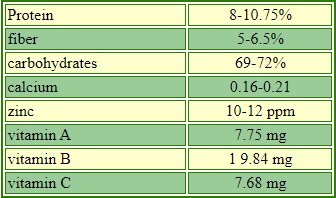
Health Benefits
- Monstera Deliciosa Fruit is loaded with lots of Vitamin C.
- It contains 60 mg per 100 grams of fruit, more than 22 grams of protein, lots of good carbs, some B Vitamins, almost no fat, calcium, and phosphorus.
- Monstera Deliciosa Fruit is full of large amounts of Vitamin C, which is a great antioxidant that keeps away disease.
- Some athlete's take Monstera Deliciosa Fruit made into a smoothie is great for instant energy and increased stamina. And if you have a long run, swim, or bike trek ahead of you Monstera Deliciosa will provide the calories you need to get you going.
- It's great for those recovering from radiotherapy.
Recipe
Prepare Delicious Monster
- Place the fruit in a paper bag or upright in a glass, stem side on top. Let it ripen naturally – which takes 2-4 days depending on the age of the fruit and the humidity.
- When the scales have started to peel off, gently remove remaining scales with your fingers, revealing the soft white flesh underneath.
- Using a thin knife, remove the now delicate and somewhat slimy scales from the hard and inedible core.
- Mix into a smoothie, sprinkle on yogurt or cereal, or eat raw for an unbelievably delicious treat!
- Place the whole fruit upright in a glass or in a paper bag to ripen, stem side up
- Fruit is allowed to ripen naturally and the scales fall off
- Peel away the green scales to reveal the white flesh underneath
- Cut the flesh away from the core
Precaution
- Because of its high content of oxalic acid, the unripened fruit can be toxic, causing itching, swelling and asphyxiation. But if you've bought the fruit rather than hacked it off a tree yourself, you're good. The mature fruit contains a small amount of oxalic acid, which is common in a few other fruits and may cause a slight itchiness in the mouth and tongue if you're sensitive to certain allergens.
Ripe kernels of fruit generally fall off on their own when ready to eat. The flesh can be eaten on its own or added to blended drinks or cocktails. Mix with bananas, pineapples or mango for a tropical fruit salad. Sprinkle on top of ice cream, tarts, and creamy or custard-based desserts. Replace pureed Monstera anywhere you would use pureed banana, such as banana bread or cakes. Keep at room temperature, or to ripen more quickly, wrap the entire fruit in a paper bag.
Chayote is a green pear shaped squash from a family of bottle gourd. It is considered as a vegetable rather than a fruit. Chayote is crunchy and has mild sweetness with light notes of cucumber. It is prepared like a vegetable and every part of it is edible from seed to skin. Chayote squash can be consumed raw or cooked. Chayote is loaded with nutrients and antioxidants. It is rich in Vitamin B9, Vitamin C, Vitamin B6, manganese and copper. It may promote your heart health and blood sugar level. Chayote is rich in fiber which helps to maintain your body weight. Raw chayote makes a great addition to smoothies and salads. It can be steamed, roasted and fried to boost your health.
Nutrition chart and value
One of the greatest attributes of chayote squash is its nutrition content, as it offers various essential vitamins, minerals, and fiber. A single chayote squash (203 grams) provides the following nutrients
- Calories: 39
- Carbs: 9 grams
- Protein: 2 grams
- Fat: 0 grams
- Fiber: 4 grams — 14% of the Reference Daily Intake (RDI)
- Vitamin C: 26% of the RDI
- Vitamin B9 (folate): 47% of the RDI
- Vitamin K: 10% of the RDI
- Vitamin B6: 8% of the RDI
- Manganese: 19% of the RDI
- Copper: 12% of the RDI
- Zinc: 10% of the RDI
- Potassium: 7% of the RDI
- Magnesium: 6% of the RDI
Edible Uses
Chayote is very versatile and relatively easy to acquire and prepare. These squashes are bright green and pear-shaped, with lots of ridges on their skin. Their mild flavor lends itself to both sweet and savory dishes. Although botanically classified as fruits, chayote squashes are prepared like vegetables. Every part of the squash can be eaten, including its skin, flesh, and seeds. You can consume it raw or cooked. When served raw, it makes a great addition to smoothies, slaws, and salads. Alternatively, it's easily steamed, roasted, or fried. You could even consider adding it to soups, stews, and casseroles for an extra boost of nutrition.
Health Benefits
- Rich in Nutrient
- Antioxidants are compounds found in a variety of foods that protect against cellular damage, reduce inflammation, and lower stress within your body
- Eating chayote squash may improve several heart disease risk factors, such as high blood pressure, high cholesterol, and poor blood flow.
- Chayote squash is low in total carbs and high in soluble fiber, which may help regulate blood sugar levels
- During early pregnancy, folate is required for proper development of the fetal brain and spinal cord. Adequate folate intake may also play a role in preventing preterm births. Chayote is an excellent source of folate, providing over 40% of the RDI in one squash.
- One of the main theories of aging centers on molecules called free radicals that inflict damage on your cells, ultimately leading to reduced functionality over time
- Fatty liver disease is a condition in which excess fat is deposited into liver tissue. Too much fat in your liver can affect its ability to function properly
- Chayote squash boasts very few calories but a lot of fiber — two attributes which can support a healthy weight
- Your digestive tract is responsible for a variety of essential functions, including detoxification, immunity, and digestion and absorption of nutrients
- Higher fruit and vegetable consumption is associated with a reduced risk of various types of cancer, including those of the digestive tract
Chayote squash is low in calories but packed with fiber, antioxidants, and essential nutrients that make it a healthy addition to almost any diet.Its potential benefits include supporting a healthy pregnancy and promoting heart health. Colorful and easy to prepare, chayote is worth trying out as part of a balanced diet.
Zucchini is a dark or light green summer squash, which is usually harvested when it is immature to have soft edible seeds. It has a mild sweetness with floral notes. Zucchini has a soft and spongy texture. Zucchini looks like a cucumber, but unlike cucumber it is usually served cooked. Zucchini is treated as a vegetable rather than a fruit. Zucchini is loaded with nutrients including Vitamin C, Vitamin A, potassium, folate and fiber. It decreases the risk of stroke, reducing high pressure and lowers the cholesterol level in our body. It can be boiled, grilled, barbecued, and steamed according to your taste.
Health Benefits
- Zucchini has high amount of water and fiber along with the low amount of calories. Those people who are on diet should add Zucchini which provides enormous health benefits.
- Zucchini is an excellent source of Vitamin C and Manganese which helps to maintain the health. Magnesium, Vitamin A, Copper, Potassium and Phosphorus are also contained in Zucchini.
- Zucchini helps to cure BPH (Benign Prostatic Hypertrophy). Due to the enlargement of prostate gland, there will be difficulty in the urinary and sexual function which is called prostatic hypertrophy. Zucchini helps to treat the BPH symptoms if combined with the foods that are rich in phytonutrients.
- The regular consumption of Zucchini helps to prevent diseases and various health ailments.
- Zucchini has high amount of Vitamin C and Manganese which is required to maintain the healthy heart. It prevents atherosclerosis and heart disease.
- The high amount of Vitamin C in the blood helps to lower the chances of stroke by 42%
Nutritional Value
One cup of 113 grams of raw Zucchini contains 18 calories, 1.37 grams of protein, 0.2 grams of lipid fat, 1.2 grams of dietary fiber and 2.49 grams of total sugars. The same amount offers about 21.33% of Vitamin C, 18.92% of Vitamin B6 and 12.31% of Vitamin B2.

- The seed can prevent the kidney stones.
- In Africa, pulp is used as poultice to cure burns, inflammations and as a cooling compress as a treatment for neuralgia and headache.
- Seeds are consumed as an anthelmintic.
- In Mauritius, seeds infusion is used internally for treating prostate complaints and hypertension whereas the external use helps in treating erysipelas.

- The immature fruits are consumed as vegetables by steamed, grill, boiled, baked, stuffed, fried, hollowed or barbequed.
- In Libya, Zucchini is filled with rice, minced meat, herbs, spices and then steamed.
- Turkey dish named mücver is a pancake made from zucchini, flour, eggs which is gently fried in olive oil and consumed with yogurt.
- Flowers are stuffed, battered or deep fried to make a Japanese dish called tempura.
Italians brought Zucchinis to the United States in 1920s. April 25th is celebrated as National Zucchini Bread Day. Mild bitterness in Zucchini may be a result of low moisture, high temperature, low soil nutrients, etc. The world's largest zucchini on record weighed about 65 lbs and was 69 1/2 inches in length.
Muskmelon or cantaloupe has a greenish brown rough exterior with orange flesh. The ripe cantaloupe has a sweet, juicy , soft and orange flesh. The orange flesh is due to the presence of beta carotene. Cantaloupe has a high water content but that doesn't mean it lacks nutrients. It is particularly rich in Vitamin A, which can provide 100% of your daily needs of Vitamin A. Cantaloupe is a good source of Vitamin C and potassium. The Vitamin A is good for your overall eye health and it prevents age related visionary problems. The Vitamin C boosts your immunity, skin health and cellular health.
Health benefits
- Cantaloupes contain zeaxanthin which is especially good for eye sight and preventing age-related vision problems.
- Cantaloupe is the most nutrient dense melon; a single serving provides around half of your daily vitamin C and A needs,
- It is packed with skin-friendly collagen that helps keep the skin tissues tight and prevents it from withering.
- Muskmelon's rich concentration of vitamin C makes it one of the best foods you can add to your diet for strong immunity.
- Muskmelon makes for one of the most loved summer fruits because of its high water content.
- Since muskmelon is immensely rich in Vitamin A, it could do wonders for your hair too. Vitamin A is vital for healthy hair and hair growth. Vitamin A also facilitates sebum production.
- Cantaloupe or muskmelon can be a great pick for hypertension patients too. The fleshy fruit is rich in potassium which acts as a vasodilator. It relaxes the blood vessels, thereby aiding smooth inflow of blood, which further checks blood pressure levels.
- Cantaloupes boast of a decent quantum of dietary fibre. Fibres add bulk to the stool and facilitate bowel regularity, which further enhances digestion.
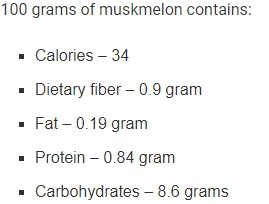
Interesting Facts
Muskmelon belongs to Cucurbitaceae, and it has an array of siblings that includes squash, melon, cucumber, guard, and pumpkin. It has a low number of calories. Cantaloupe, also known as Muskmelon, is packed with antioxidants and Vitamin A that helps to protect from many health problems. They have 90% of water. Its plant can grow 5 feet long.
With the abundance of nutrients, fiber, and water content, Muskmelon offers several health benefits. It can be consumed in the form of smoothie, salad, or you can use muskmelon seeds in your favorite dishes while cooking.
Bilberry is in red or purple color with light green pulp. Bilberry is known as European blueberry as both of them have many similarities. Bilberry is a nutrient rich fruit like berries. It contains a good amount of manganese and Vitamins C and K. Bilberries are rich in antioxidants, tannins and phenolic acids. Bilberry is used to treat visionary problems, diarrhea and menstrual cramps. Bilberry has a substance called anthocyanosides which have anti inflammatory properties and may improve night vision.
Nutrition Value

Types
- Vaccinium myrtillus L. (bilberry)
- Vaccinium uliginosum L. (bog bilberry, bog blueberry, bog whortleberry, bog huckleberry, northern bilberry, ground hurts)
- Vaccinium caespitosum Michx. (dwarf bilberry)
- Vaccinium deliciosum Piper (cascade bilberry)
- Vaccinium membranaceum (mountain bilberry, black mountain huckleberry, black huckleberry, twin-leaved huckleberry)
- Vaccinium ovalifolium (oval-leafed blueberry, oval-leaved bilberry, mountain blueberry, high-bush blueberry).
Health Benefits
- Bilberry exerts defensive effect against restraint stress stimulated liver damage owing to the presence of antioxidants
- In Europe, health care professionals use bilberry extracts to treat this condition, which occurs when valves in veins in the legs that carry blood to the heart are damaged.
- Bilberry leaves have been used traditionally to control blood sugar levels in people with diabetes.
- Research show that anthocyanosides present in bilberry may strengthen blood vessels, improve circulation, and prevent the oxidation of LDL ("bad") cholesterol.
- Bilberry extracts are effective against the development of various cancers including colon cancer, breast cancer and leukemia.
- Bilberry extract might be utilized to assist treat UTIs, too, because of the fact that it's a close cousin towards the cranberry
- Bilberry is useful for the maintenance of eye health.
- Bilberry has additionally been utilized as cure for numerous skin conditions, just like skin ulcers as well as varicose veins.
- The extract of the bilberry fruits and leaves is a well-liked component utilized for cosmetics.
How to eat
- Raw: Bilberry can be simply eaten raw for a quick snack.
- Tea: Bilberry can be enjoyed as a warm cup of tea.
- Pie: You can create a delicious pie by using bilberries as the filling.
- Juice: The berries can be turned into a juice that you can enjoy any time of the day.
- Jam: Simply boil the berries in water and a natural sweetener to make a delicious jam that you add to your favorite foods.
Bilberries are eaten fresh or processed into jams, pies, baked goods, juices, flavoring agents in ice-cream and used in liqueur.
Dragon fruit is commonly available in bright pink exterior with protruded green scales resembling a dragon. They have a white pulp with black crunchy seeds. It may be alluring , but it tastes like a combination between a kiwi and pear. Dragon fruit is loaded with fiber, vitamins and carotenoids. It also has the average amount of magnesium, iron and Vitamin C. The carotenoids and lycopene present in dragon fruit may reduce the risk of chronic disease like heart disease, cancer, arthritis and diabetes.
Description
The dragon fruit has a dramatic appearance, with bright red, purple or yellow-skinned varieties and prominent scales. The fruit is oval, elliptical or pear-shaped. The flesh has a subtly flavoured sweet taste or sometimes slightly sourish taste. The flesh is either white or red, with edible black seeds dotted all over.
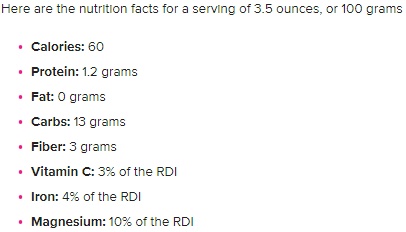
Health Benefits
- It's rich in antioxidants like flavonoids, phenolic acid, and betacyanin. These natural substances protect your cells from damage by free radicals -- molecules that can lead to diseases like cancer and premature aging.
- It's naturally fat-free and high in fiber. It makes for a good snack because it can help keep you full for longer between meals.
- It may help lower your blood sugar. Researchers say this might be partly because it replaces damaged cells in your pancreas that make insulin, the hormone that helps your body break down sugar.
- It contains prebiotics, which are foods that feed the healthy bacteria called probiotics in your gut. Having more prebiotics in your system can improve the balance of good to bad bacteria in your intestines.
- It can strengthen your immune system. Dragon fruit is high in vitamin C and other antioxidants, which are good for your immune system.
- It can boost your iron levels. Iron is important for moving oxygen through your body and giving you energy, and dragon fruit has iron. And the vitamin C in dragon fruit helps your body take in and use the iron.
Edible uses
- You can eat dragon fruit in a few ways. Toss it into a fruit salad along with other tropical fruits like pineapple and mango. Cut it into a salsa. Churn it into ice cream. Squeeze it into juice or water. Use it as a topping for Greek yogurt. Or freeze it and blend it into a smoothie.
Dragon fruit is also known as pitaya and can be eaten raw or made into juice. It is also used to add flavor and color to alcoholic beverages.
Kiwano melon is an exotic oblong fruit. It is known as horned melon as it has rigid spikes all over the thick orange skin. It has a juicy lime green pulp with mild sweet flavor like cucumber with the trace of banana. Kiwano melon contains magnesium, iron, Vitamin B6, Vitamin C, Vitamin A and calcium. The antioxidants present in the kiwano melon helps your nervous system stay healthy and may protect from chronic disease. Kiwano melon helps to clean the urinary tract and facilitate healthy digestion. It helps to repair the damaged skin and tissue.
Health Benefits
- A couple of the anti-oxidants recognized in horned melon seeds usually are a-tocopherol as well as y-tocopherol. Both of them are organic types of vitamin E.
- A kiwano consists of 307 IU of vitamin A, or even 6 % of the 5,000 IU suggested every day. Vitamin A is a vital nutrient for the assistance of the retina function within the eye which retains eyesight.
- A kiwano offers 1 mg of zinc, or 7 % of the 15 mg required every day. On average, most Americans usually do not eat the minimal every day requirement of zinc, in accordance with Ohio State University.
- A kiwano offers 11 mg of vitamin C, or 18 % of the FDA suggested Daily Value of 60 mg. Including concentrated sources of vitamin C within the diet is essential because the nutrient is required for the function of numerous body systems.
Uses
- The green jelly-like flesh is scooped out of the spiny fruit shell and consumed together with a little sugar.
- The pulp and seeds of those fruits are combined within a mixer for producing a rejuvenating drink.
- This fruit pulp is additionally spooned over sorbets, ice creams and also yoghurts to include a unique taste.
How to Eat

- Choose a Horned melon fruit which have a completely ripened. It'll have an orange rind along with spikes. If you can't get a fully ripened fruit, wait to get a turn orange just before eating it.
- Cut the fruit in two crosswise. Set the one half aside.
- Hold the rest of the half in your mouth. Gradually, press the fruit from the lower end. Tiny, semi-slimy sacs of fruit, each containing a cucumber-like seed, may come to the cut surface of the fruit.
- Beat or even suck up a minimum of one sac of fruit and seed.
- Chew or even suck on the sac of fruit, swallowing it once you've savored the tastes.
Kiwano melon is an exotic fruit, originating from Africa, that offers several health benefits due to its rich nutrient profile.
Acai berries have a dark purple skin having yellow flesh surrounding a seed. It gives a mixed flavor of BlackBerry and cocoa. Acai berries have a plenteous amount of antioxidants than any other berry which helps to neutralize the free radicals in the body. It may reduce the risk of heart attack and lowers the bad (LDL) cholesterol level. Fresh acai berries have a short life so they are processed into dried powder, frozen fruit puree and juice. It is used as a flavoring agent in jellies, ice cream and sorbet.
Description
Acai plum is a tall, slim, multi-stemmed evergreen palm tree that grows more than 25 m (82 ft.) tall. The plant is found growing in swampy ground, often in sandy soils. Most commonly found along river edges and seasonally flooded habitats. The plant prefers well drained, organic soils that are acid rich, like peat, moss, and pine needles.
Health benefits
- Regulate Blood Pressure
- Delay Premature Aging
- Skin Care
- Boost Immunity
- Aphrodisiac
- Improve Cardiovascular Health
- Aid in Digestion
- Weight Loss
- Improve Metabolism
- Boost Energy
- Promote Wound Healing
Precautions
- Avoid it during Hypersensitivity.
- If you are on chemotherapy, consult your doctor before taking Acai.
- Do not take it with other cancer fighting medicines.
- Overconsumption of acai berries may cause diarrhea, irritation in the intestinal tract, headaches, and reduced vision.
- Juice from the fruit is a refreshing drink that is often served ice cold or made into ice cream, liquor, mousses, and sweets in general.
How to Eat
- Açaí is sold as frozen pulp, juice, or an ingredient in various products from beverages, including grain alcohol, smoothies, foods, cosmetics and supplements.
- It is often used to make a drink that is very popular in the Amazon region of Brazil.
- Juice is served ice cold with (or sometimes without) sugar and tapioca flour.
- It is a nourishing and refreshing drink that is also used to produce ice cream, liquor, mousses and sweets in general.
- Juice is also added to various foods such as tapioca, cassava and porridge.
- Leaves when cooked are crunchy, with a sweet flavor.
Edible oil is obtained from the seed. With its very attractive flowers, it is also desirable as an ornamental or garden plant for homes around the world with suitable climate.
Date or date palm is the fruit of a date palm tree. There are different types of dates ranging from bright red to yellow color. Dates are consumed raw or dried, but dried dates are commonly preferable. Dried dates is a chewy fruit with sweet flavor.Dates are loaded with carbohydrates that is 100g of dates and provides you 75g of carbs. It has a moderate amount of potassium, magnesium, copper, manganese, Vitamin D6 and iron. Dates are high calorie and fiber as they are a dried fruit. Dates can be replaced with sugar as it has fructose in it.
Description
The date is the fruit of the date palm. It is a berry of golden yellow colour or reddish-brown when ripe. Its meat is soft, aromatic and sweet, with a stone inside it of elongate shape and with a longitudinal furrow.
Health Benefits
- Very Nutritious
- High in Fiber
- High in Disease-Fighting Antioxidants
- Promote Brain Health
- Promote Natural Labor
- Excellent Natural Sweetener
- Other Potential Health Benefits
- Easy to Add to Your Diet
Dates promotes regular bowel movement which prevents constipation. It balances the blood sugar level. The antioxidants such as flavonoids, carotenoids and phenolic acid helps to reduce inflammation, risk of diabetes, cancer, visionary problems and heart diseases. Dates may improve your brain health and reduce the risk of Alzheimer’s disease.
Mangosteen is said to be the queen of fruits. Mangosteen has a deep reddish purple colored crust with a cotton like white fibrous juicy pulp. The fully ripe mangosteen has a sweet and tangy edible flesh with the almond shaped edible seeds.
Description
Mangosteen provides many essential nutrients such as folate, thiamine, riboflavin, manganese and Vitamin C. It provides the average amount of copper, magnesium, fiber and protein. Mangosteen is rich in antioxidants which have anticancer, anti-aging, anti-inflammatory and anti diabetic properties. Xanthone and fiber compounds present in mangosteen balance blood sugar level. It promotes healthy skin and a healthy immune system.
Health Benefits
- Highly Nutritious
- Rich in Powerful Antioxidants
- Anti-Inflammatory Properties
- Anticancer Effects
- Promote Weight Loss
- Blood Sugar Control
- Healthy Immune System
- Maintain Healthy Skin
- Potential Health Benefits
How to Eat
- Choose mangosteens with a glossy sheen.
- Remove the top leaves and stem from the top of the fruit.
- Press in on the top of the fruit.
- Squeeze on the sides until the purple shell cracks.
- Make a shallow, horizontal cut around the shell if it's tough.
- Eat the white flesh inside of the fruit.
Mangosteen might slow blood clotting. Taking mangosteen might increase the risk of bleeding during or after surgery
Guarana is the climbing plant which is well known for its seeds. The fruits are grown in clusters and it ranges from red to brown color. Guarana contains a coffee bean sized seed in black color covered by white seed covering which resembles the eye balls. Guarana seeds have a unique taste with earth or woody flavor. Guarana seeds are processed into soft drinks and supplement powder.
Benefits
- Rich in Antioxidants
- Reduce Fatigue and Improve Focus
- Weight Loss
- Relieve Chronic Diarrhea and Treat Constipation
- Boost Heart Health
- Pain Relief
- Improve Skin Appearance
- Anti-Cancer Properties
- Protect Against Age-Related Eye Disorders
Guarana is enriched with antioxidants which include tannins, theobromine, caffeine and catechin. It promotes weight loss and it is used to improve your mental energy and focus. Guarana can reduce fatigue and relieves pain so it is used as an energy drink for athletes. Tannins and caffeine present in guarana helps you to treat diarrhea and constipation.













